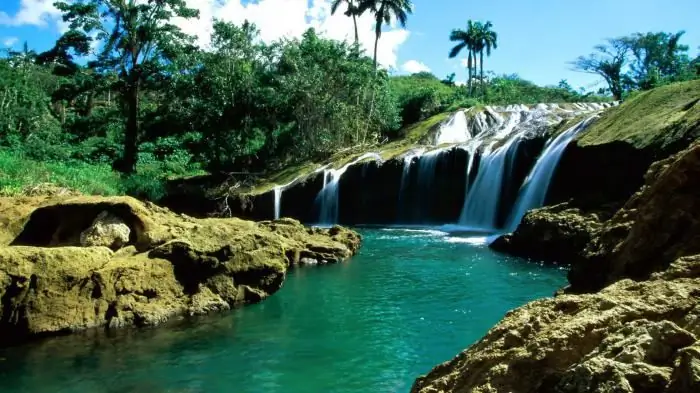- Author Harold Hamphrey [email protected].
- Public 2023-12-17 10:06.
- Last modified 2025-01-24 11:10.
Tourists regard Italy primarily as a country of sightseeing, educational recreation. The eternal city of Rome, no less ancient Florence, Verona, Naples, bewitching Venice, the mysterious island of Sardinia, luxurious Milan… Tourists bring a huge amount of knowledge and impressions from trips to these places. Italy is also famous for its seaside resorts. Summer holidays on the lakes of the north of the country are also popular - Garda, Lago Maggiore, Como. But no less than cities and beaches, tourists are attracted by the mountains of Italy. What are their names? Even a schoolboy knows that the Italian "boot" is called the Apennine Peninsula because of the mountain system of the same name. On its northern border are the majestic Alps. The snow-covered four-thousand-meter peaks look like the fur edge of an Apennine boot in pictures from space. But the list does not end there either. What mountains are in Italy, what are they called and what are they characterized by - read in this article.

Alps
This is a huge mountain system that stretches across the territory of not only Italy, but also Germany, Austria, Switzerland and France. It is in the Alps that the highest point in Europe, Mont Blanc, is located. A caveat needs to be made here: this is leadershiptakes place if we consider the Caucasus Range as part of Asia. The height of the "White Mountain" (as the name Mont Blanc is translated) is 4808 meters, while Elbrus rises above sea level at 5642 m. The Alps are considered a mountain system. It consists of many ridges. What are the Italian Alpine mountains called? The list is quite extensive. We can say that the Alpine part of the country is divided into Western, Southern and Eastern. The boundaries between them are rather arbitrary. We will consider in order all the Alps, Apennines, mountains and volcanoes of Sicily. Let's start from the highest point in Italy, and at the same time throughout Western Europe - Mont Blanc.

Western Alps
The conditional border in the east of this mountainous region runs along the line connecting lakes Como and Lake Constance. The Western Alps are heterogeneous. They, in turn, are made up of smaller parts. France borders such Italian mountains as the Maritime and Ligurian Alps. If we follow the map further to the northeast, we will see that the mountains in this part are getting higher. These are the Kotsky, Provencal, Dauphine, Bernese, Gray, Pennine, Glarn and Lepontian Alps. These mountains are characterized by steep slopes and deep gorges. It is here that ski resorts are located, which receive tourists all year round. Indeed, in the Western Alps there are massive glaciers. In this part there are also independent mountain ranges - Pelva and Vercors. The highest peaks are in the Pennine Alps. These are such four-thousanders as Mont Blanc, Monte Rosa and Cervinha. The last peak has another name - the Matterhorn.
Central Alps
This part of the mountain system extends along that northern border of Italy, which is adjacent to Eastern Switzerland and the Austrian province of Tyrol. She is also very tall. But the peaks here reach only 3899 meters above sea level (Ortles). What are the mountains of Italy in this area called? Allocate the Lombard Alps, and in them - Bergama. Here the highest point is Mount Coca (3052 m). The border between Italy and Austria runs along the massif called the Ötztal Alps. The highest point of this ridge - Mount Wildspitze - reaches 3768 meters in height. In the east, the Ötztal Alps merge into the Stubai. In this massif, the Zuckerhüll peak (3507 m) is considered the highest point. Glaciation also occurs in the Central Alps (in the Ortles, Adamello and Bernina massifs). These ranges are characterized by a wide band of foothills. They are occupied by alpine meadows. Where the slopes divide the spur valleys, there are the most beautiful mountain lakes.

Eastern Alps
This is a small area. And not the highest in the Alps. But that doesn't make it any less picturesque. The Eastern Alps are subdivided into Julian and Dolomites. The first mountain system is partially located in Italy (the region of Friuli-Venezia Giulia), as well as in the Slovenian Krajina. The name of these Alps comes from Julius Caesar, who marched here with an army and founded the province of the Roman Empire with Cividale as its capital. The highest point of this massif (and at the same time Slovenia, and the entire former Yugoslavia) is Mount Triglav. Its height is 2864 meters above sea level. But the Julian Alps should not be underestimated. This is heaven forspeleologists. Here is one of the deepest caves in the world - Cheki-2. It goes underground for one and a half kilometers. And in the Vrtoglavice cave there is the deepest continuous natural well (six hundred meters). In this part of the Alps there are mountains of Italy that deserve special mention.

Monte Pallidi
This was the name of this ridge system until the French geologist Deodat de Dolomieu arrived there in the eighteenth century. He investigated the mineral from which these Monte Pallidi, the Pale Mountains, were mainly composed. The breed has an interesting property to reflect the sun's rays. The mineral was named after the French geologist dolomite. Perhaps these are the most beautiful mountains in Italy. Photos of dolomites, illuminated by the setting sun and shimmering in different colors, from red to cream, are the hallmark of this massif. Monte Pallidi stretched for one hundred and fifty kilometers. They have eighteen peaks, the height of which overcomes the mark of three thousand meters (Mount Marmolada). It should be said about the unusual origin of the Dolomites. These are coral reefs that have risen up as a result of volcanic activity. In Monte Pallidi, which in 2009 were fully included in the list of natural heritage of mankind, there are many reserves. Dolomiti Bellunesi is the most famous of them.

Apennines
The question of where the mountains are in Italy is an idle one. They are everywhere, except for the wide Po valley and the lowlands near Venice. Along the entire Italian "boot" onOne and a half thousand kilometers stretched the Apennines, which gave the name to the entire peninsula. They are inferior to the Alps in height. The highest point of the Apennines - the peak of Corno Grande - does not reach even three thousand meters above sea level. However, these are the youngest mountains on our planet. A very extended system, of course, is divided into massifs, chains and ridges. The highest is the Gran Sasso. The name of this mountain range is translated as "Big Stone". It is in it that the top of Korno (2914 meters) is located. Since the Apennines are young mountains, volcanic activity has not died out in them. Unfortunately, earthquakes are also frequent. Vesuvius is one of the famous volcanoes. Its height is only 1277 meters, but the eruptions are very powerful. Amiata is another highest mountain in the Apennines with volcanic activity. In the southeastern part of this system, there are the karst and lava plateaus of Le Murge and Monte Gargano. The Apennines, merging with the Ligurian Alps in the north, smoothly pass to the mountains of Sicily in the south. The mountains on the toe of the Italian "boot" reach a height of 1956 m. They are called the Calabrian Apennines.

Mountains of the Italian Islands
Let's first consider Sicily - a "pebble" that kicks a "boot". The relief of this island is also very mountainous. In a relatively small space, several arrays fit at once. These are Peloritani, Nebrodi, Le Madonie and the Ibleian Mountains. This whole system is related in origin to the Apennines. Here, too, volcanic activity has not died out, which is manifested in the obstinate and unforeseencharacter of Etna. The height of this mountain reaches 3340 meters above sea level. Near Sicily are the islands of Vulcano and Stromboli. Scientists associate their origin with the underground activity of the bowels. Sardinia in relief is not much different from Sicily. Here are located such mountains of Italy as Gennargentu. This is a low chain. The main peak - Mount La Marmora - reaches 1834 meters.

Ski holidays in Italy
Surprisingly, the most popular are the Alpine resorts, although there is no shortage of them in the Apennines. Probably the reason is that in Lavigno, Cervinia you can ski all year round because of the glacier. The Apennines attract not only skiers. Alternative types of outdoor activities are developed here: rock climbing, trekking, orienteering. The Alpine resorts of Italy are not much inferior to the world-famous Swiss Courchevel. And their prices are lower. And no matter which mountains in Italy you choose for your winter holidays, first-class service awaits you everywhere. It is interesting that, having risen on the lift to the top of the ski slope in Cervinje, you can famously move off … to Switzerland. Popular with tourists are resorts such as Bormio, Dolomiti-Superski and Cortina d'Ampezzo. In the extended Apennine mountains there is an array of Abruzzo. It is famous not only for its ski resorts, but also for its picturesque villages, clinging like swallows' nests above the cliffs. People come here to ride and visit national parks, because virgin nature with numerous lakes has been preserved here.
Rest in the mountainsItaly on thermal waters
The youth of the Alpine and Apennine systems, not extinct volcanic activity contributed to the emergence of many hot springs. Resorts appeared in their place in the Middle Ages. They are called "terme" (baths). These are not saunas and not Russian steam rooms, although recently there are also plenty of such spa services. The most famous thermal resorts in the Alps are Sirmione (on Lake Garda, in Lombardy), Abano Terme (in the province of Veneto), Erbusco and Merano (in South Tyrol). In the Apennines, the most popular are San Giuliano Terme, Terme de Medici, Monsumman and Montecatini.






